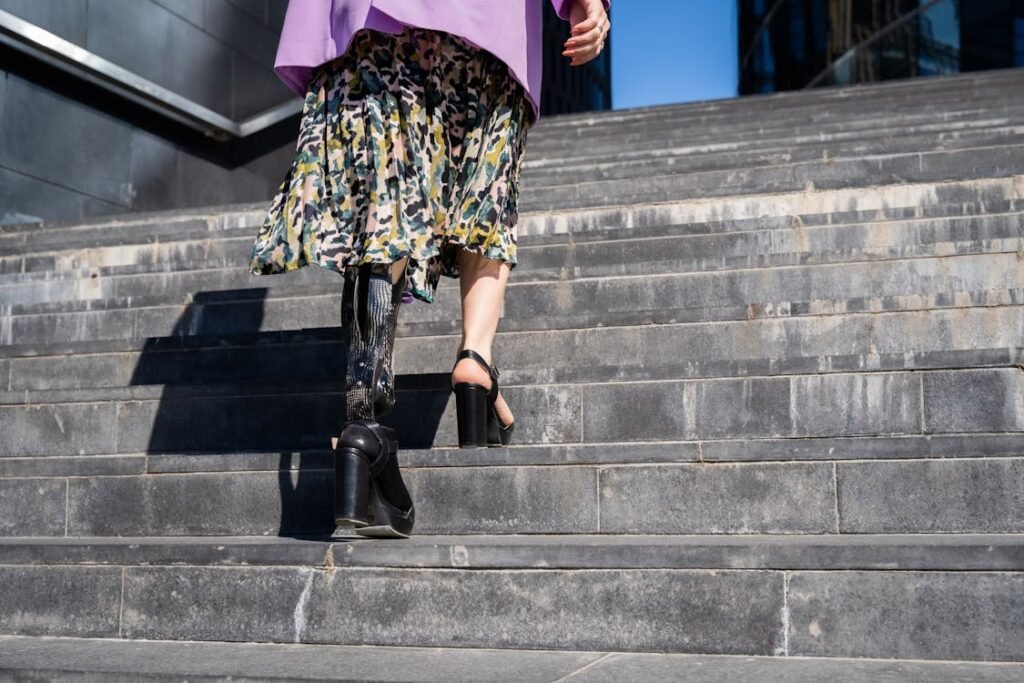Losing a limb is one of the hardest moments in anyone’s life. It brings with it a wave of emotions, pain, and uncertainty. But as heavy as that moment is, it’s not the end of the road. In fact, it’s the beginning of a new journey—one where the right guidance, support, and tools can make all the difference.
At Robobionics, we’ve worked closely with patients, families, surgeons, physiotherapists, and prosthetists for years. We’ve seen what works, what doesn’t, and how timing can change everything when it comes to prosthetic fitting. One of the most common questions we hear is: “When should I get my prosthesis?” And it’s a very important question—because getting fitted too soon can hurt recovery, while waiting too long can slow it down and cause problems that are harder to fix.

What Happens Right After Amputation
The hours and days that follow an amputation are full of change—both outside and inside the body. It’s not just the absence of the limb that needs to be addressed. The body has just gone through a major surgery, and now begins the delicate process of healing.
This period is crucial, because how the body recovers in the beginning sets the tone for everything that comes next, including when and how a prosthetic limb can be introduced.
The First Stage: Wound Healing and Stabilization
Once the surgery is complete, doctors focus on protecting the surgical site. The wound is carefully dressed, and in many cases, a rigid or soft dressing is applied to keep the area stable and clean.
This not only shields the site from infection but also starts shaping the residual limb, which is something many people overlook but is essential for a future prosthetic fit.
During this early phase, swelling is expected. It’s a natural reaction, but it needs to be controlled. Doctors and nurses closely monitor the limb to make sure healing is progressing without complications like infections, blood clots, or pressure sores.
Pain is usually managed with medication, and patients are encouraged to begin gentle movements as soon as it’s safe to do so.
This is not the time for a prosthesis yet, but it is the time to begin talking about one. Having early conversations with your surgeon, physiotherapist, and prosthetist can set you up for success.
It gives the entire care team a chance to start planning your recovery around your needs and lifestyle.
Emotional Reactions and Mental Adjustments
Right after surgery, it’s also common for emotions to run high. Some people feel relief—especially if the surgery removed long-standing pain or infection. Others feel grief, confusion, anger, or sadness. None of these emotions are wrong. In fact, all of them are normal.
The emotional healing is just as important as the physical recovery. Patients often ask, “How soon will I walk again?” or “Will I be able to do the things I used to love?” While these are future-focused questions, they start showing up early. They’re part of trying to understand this new version of life.
Being supported by a strong care team makes a big difference here. Hospitals and rehab centers often include counselors or support groups to help patients cope. In our experience at Robobionics, just having someone to talk to—someone who’s been there—can offer hope and clarity during this time.
The First Two Weeks: Laying the Groundwork
In most cases, the first 10 to 14 days after amputation are focused on letting the body recover from the surgical trauma. The wound needs time to close, the skin needs to heal, and the patient needs to regain some basic strength. But this doesn’t mean sitting still the whole time.
Doctors may suggest simple movements—flexing and extending nearby joints—to prevent stiffness and improve blood circulation. If the patient is strong enough, they might also start using a wheelchair or even practice balancing exercises while seated.
These small actions keep the body engaged and help prepare it for the next steps.
At this stage, the prosthetist might visit the patient to begin early evaluations. They don’t take measurements yet, but they assess the healing, look at the shape of the residual limb, and answer questions. Most importantly, they start educating the patient about what’s coming next.
That early education is key. When people understand how the process works, it reduces fear. It creates a sense of control. Even if a person isn’t ready for the prosthesis right away, just knowing that a plan is in place brings peace of mind.

Weeks 3–6: The Most Critical Phase for Shaping and Preparation
This period, usually between the third and sixth week after amputation, is one of the most important stages in the entire prosthetic journey. During this time, the body starts stabilizing.
The surgical wound has usually closed, the swelling begins to reduce, and the patient’s energy starts to return. It’s also the time when things begin to feel real. The loss sinks in more deeply, but so does the hope of getting back on your feet.
The Body Begins to Adapt
By now, the body is working hard to adjust to the changes. Muscles start rebuilding. Circulation improves. And if things are going well, the residual limb begins taking on a more regular shape.
This shaping is essential—not just for appearance, but for function. A smooth, cone-shaped limb is easier to fit into a prosthetic socket. It allows for better weight distribution, reduces pressure points, and leads to greater comfort once the prosthesis is in place.
But this shape doesn’t happen on its own. It needs attention. Patients are typically advised to wear compression garments, sometimes called shrinker socks, to gently squeeze the limb and guide it into the correct form.
These garments also help reduce fluid buildup and pain. They might feel uncomfortable at first, but they are incredibly important for long-term comfort.
Massage therapy, stretching exercises, and desensitization techniques are also introduced around this time. These help the skin toughen up and get used to touch, pressure, and movement. All of this prepares the limb—and the mind—for the experience of wearing a prosthesis.
Introducing the Prosthetist More Deeply
This is the phase where the prosthetist becomes a regular part of the team. At Robobionics, we usually schedule the first proper fitting discussions during this period. It’s still too early for the final prosthesis, but it’s the perfect time for evaluations, education, and early planning.
The prosthetist will take a closer look at how the residual limb is healing. They’ll check for things like skin condition, tissue firmness, and any signs of complications.
If the limb is healing well, they may start preparing for a test socket—a temporary version that helps understand fit, alignment, and comfort.
This early involvement is not just technical. It’s emotional too. When patients meet their prosthetist and start seeing what the future holds, it replaces fear with curiosity.
It builds trust. It also ensures that any problems—like poor shaping or unexpected sensitivity—are addressed before they become long-term barriers.
The Emotional Shifts Continue
By now, many patients begin to shift emotionally. They may still feel sadness or frustration, but there’s often a sense of movement. Life no longer feels stuck. The idea of walking again becomes less of a dream and more of a real possibility.
That said, this phase can also be mentally tiring. Some people feel anxious that progress isn’t happening fast enough. Others may struggle with motivation during physical therapy.
It’s important to remember that this is completely normal. Healing isn’t a straight line—it moves in waves. Some days will feel great, others less so.
Having a consistent support system helps a lot here. Whether it’s family, a physiotherapist, a counselor, or even other amputees, staying connected helps keep the spirit strong.
At Robobionics, we always encourage patients to share their stories, speak their doubts, and ask for help when needed. No question is too small, and no fear is silly.
Physical Therapy Ramps Up
This is also the time when rehabilitation becomes more structured. Therapists guide patients through targeted exercises that improve strength, balance, and flexibility. The focus is on preparing the body for a prosthesis—even if it hasn’t been fitted yet.
Patients learn how to bear weight, stabilize their core, and control nearby joints. They may also practice using crutches, walkers, or wheelchairs to stay mobile.
These activities aren’t just about staying active—they teach the brain and body how to move again with confidence.
All of this work—shaping, therapy, emotional support, prosthetist guidance—creates the perfect foundation for the next big step: the first fitting of a temporary prosthesis.
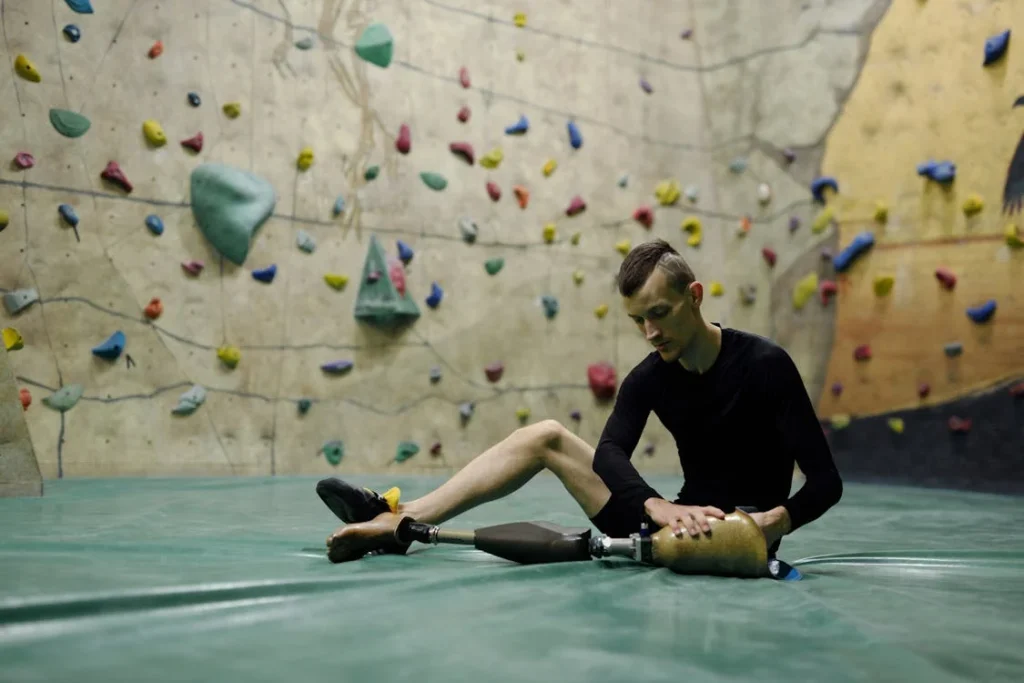
Weeks 6–12: The First Prosthesis and Learning to Use It
This stage marks a major turning point in the journey after amputation. By weeks six to twelve, most people are physically ready for their first prosthesis.
Emotionally too, many begin to shift into a mindset of recovery, readiness, and hope. This is when all the early preparation starts to show results, and the promise of walking, moving, or even just standing on one’s own again begins to come true.
The Temporary or Test Prosthesis
The first prosthesis fitted at this stage is often temporary. It’s not meant to last forever. Instead, it helps your prosthetist evaluate the shape and stability of your residual limb and how your body responds to wearing and using the device.
At Robobionics, we often refer to this as a test limb—it’s a vital part of the overall fitting process.
During this phase, the residual limb is still changing shape. Swelling is going down, and muscle tone is returning. That’s why the socket of the first prosthesis must be adjustable. It allows for small tweaks to improve comfort and fit.
If the socket is too tight, it can cause pain or pressure sores. If it’s too loose, the limb won’t be secure, which can affect balance and walking.
Adjustments are normal and expected. This is why patients visit the clinic frequently during this phase. These visits aren’t just checkups—they’re opportunities to fine-tune the fit, track healing, and build trust with the prosthetist.
First Steps: A New Chapter
For many patients, walking with a prosthesis for the first time is emotional. It can feel awkward, exciting, overwhelming—and everything in between.
The body is learning something entirely new. Even standing still with the help of a prosthetic limb takes practice and concentration at first.
With guidance from a trained physical therapist, the patient begins by learning how to balance. They practice shifting their weight from one side to the other.
They learn how to step, how to stop, how to turn. These movements may seem simple, but after amputation, they take effort and patience.
Progress during this time varies from person to person. Some people are able to walk with support within a few days. Others need several weeks.
It depends on many factors—overall health, type of amputation, strength, pain levels, and even confidence. But every step, no matter how small, is a step forward.
The goal in these weeks is not perfection. It’s progress. Each hour spent practicing, each correction made by the therapist, and each visit to the prosthetist moves the person closer to regaining independence.
Emotional and Mental Growth
This period is not just about muscles and movement. It’s also when people start to rebuild their emotional strength. When you stand for the first time after an amputation, something inside you shifts.
You feel taller. You feel more in control. Even if the walk is slow or the prosthesis feels strange, that moment stays with you. It becomes proof that life is still moving forward.
Of course, it’s not always easy. Some days the prosthesis feels heavy. Some days it rubs. Some days it feels like too much work. But each of these challenges is part of learning. Each one teaches something—how to adjust, how to care for the limb, how to listen to your body.
At Robobionics, we work closely with every patient during this stage. Not just to check the device, but to check on the person. We talk, we listen, we adapt. Every journey is different, and we’re here to walk it with you.
The Role of Continued Therapy and Training
Physical therapy during this stage is intense, but it’s also where the biggest gains happen. Therapy sessions focus on building strength in the hips, core, and the remaining limb. These muscles play a huge role in stability and gait.
Therapists also teach techniques for walking on different surfaces—like tiles, grass, or uneven roads. Patients learn how to go up and down stairs, how to get in and out of a car, and how to navigate daily life with the prosthesis.
The brain is also learning. It’s re-mapping how it understands the body. This is called neuroplasticity. With practice, the brain begins to treat the prosthetic limb as part of the body. The more the person moves with the device, the more natural it becomes.
Many patients also begin practicing routines at home. Putting on the prosthesis. Taking it off. Cleaning it. Checking for skin issues. This kind of daily use builds confidence and makes the device feel less like an object and more like a part of the body.
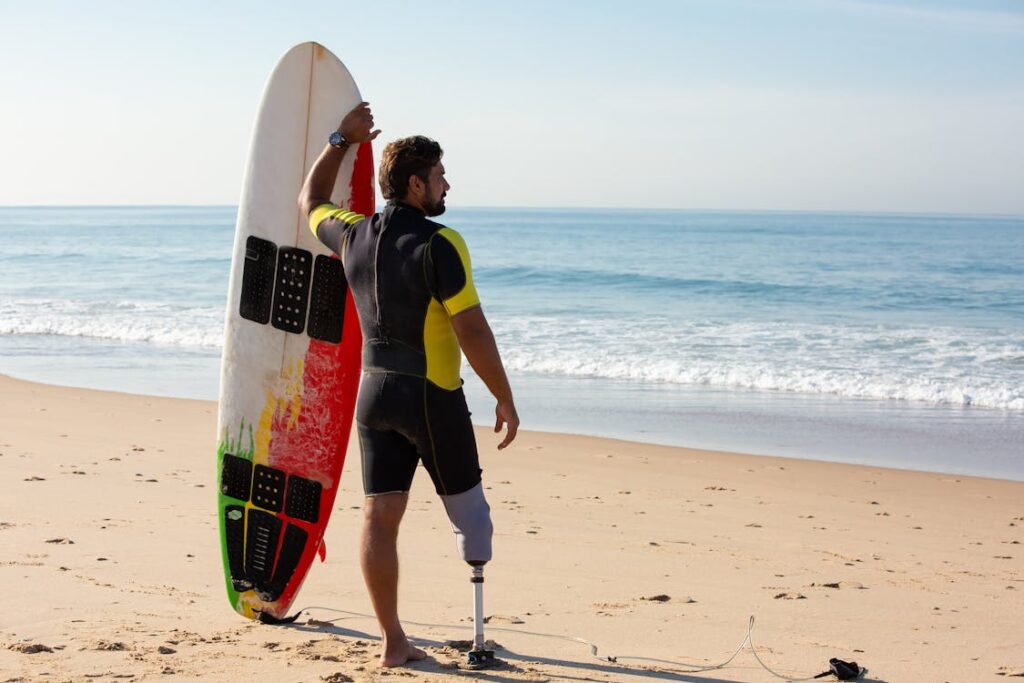
After Three Months: Transitioning to a Permanent Prosthesis
Three months after surgery is often the point when a person begins to feel truly ready. The swelling has usually gone down significantly. The residual limb has taken on a more stable shape.
Muscles have grown stronger, balance has improved, and many are already using a temporary prosthesis comfortably. This is when doctors and prosthetists typically recommend moving toward a permanent prosthetic device.
Why Timing Matters at This Stage
By the third month, the body has done a lot of healing. However, it’s still changing. That’s why most prosthetists don’t rush to provide a permanent prosthesis too early.
The limb needs to be as stable in shape and size as possible. If a permanent socket is made too soon, it may not fit well a few weeks later, causing discomfort or the need for repeated adjustments.
But waiting too long has its downsides too. When a person has gotten used to a temporary prosthesis and is doing well with it, that motivation should be used to transition smoothly into a more durable, more functional, and better-fitted permanent limb.
This is the ideal time to make that step forward, while confidence and strength are both high.
Doctors usually give the go-ahead for a permanent prosthesis when the wound is completely healed, the limb volume is consistent for a few weeks, and the patient has shown steady use of the temporary device without major issues.
This is where the close relationship between patient and prosthetist really pays off—they know what’s happening on the ground and can guide the timing precisely.
What the Permanent Prosthesis Involves
The permanent prosthesis is a much more personalized device. Every part of it—from the socket to the foot or knee unit—is designed based on how the person lives, moves, and what they hope to do. It’s not a generic limb. It’s tailored.
This customization starts with a detailed assessment. The prosthetist will ask questions about daily routines, hobbies, work demands, and long-term goals.
For someone who spends most of their day walking or standing, a lightweight, shock-absorbing limb might be ideal. For someone who wants to return to sports or high-activity work, different components are chosen that offer greater flexibility and strength.
The socket—the part that attaches to the body—is designed with extra care. At this point, digital scans or new molds are taken to match the limb’s latest shape.
The socket is made using materials that balance strength with comfort, and often includes ventilation or cushioning systems to prevent sweat buildup and skin irritation.
This stage is also when the suspension system is finalized. Whether it’s a suction, vacuum, or pin-lock setup, the method of keeping the prosthesis attached to the limb is chosen based on what the user feels most secure and comfortable with.
Fitting and Final Adjustments
Just like with the temporary prosthesis, the permanent limb isn’t “ready to go” the moment it arrives. Several fittings are usually needed to get the alignment and comfort exactly right. This is completely normal.
Each adjustment is made with feedback from the patient. If the socket feels too tight, if there’s pressure on one side, if the balance feels off—these are all things that can be fine-tuned. The goal is not just to walk, but to walk confidently and without pain.
Patients are encouraged to take their time during these fittings. Walk slowly. Pay attention to how the prosthesis feels while standing, walking, turning, and even while sitting. Every bit of feedback matters. The prosthetist listens carefully and makes the necessary changes.
This stage is where many patients also start testing their limits in new ways. Walking longer distances. Climbing stairs without support. Going outside more often.
The permanent prosthesis gives them the confidence to do so because it’s built for them—not just for healing, but for living.
Renewed Confidence and Independence
Getting a permanent prosthesis is often described as the moment life begins to feel normal again. It’s not just the ability to move—it’s the ability to live on your own terms.
Daily routines get easier. Social confidence returns. People feel more open to travel, work, and being around others. For many, this is the point where emotional healing takes a big leap.
They no longer see themselves only as a patient. They see themselves as a person in full control of their life again.
At Robobionics, we often hear from patients at this stage who say, “I finally feel like myself again.” And that’s what a well-timed, well-crafted prosthesis should do. It doesn’t just restore motion—it restores identity.
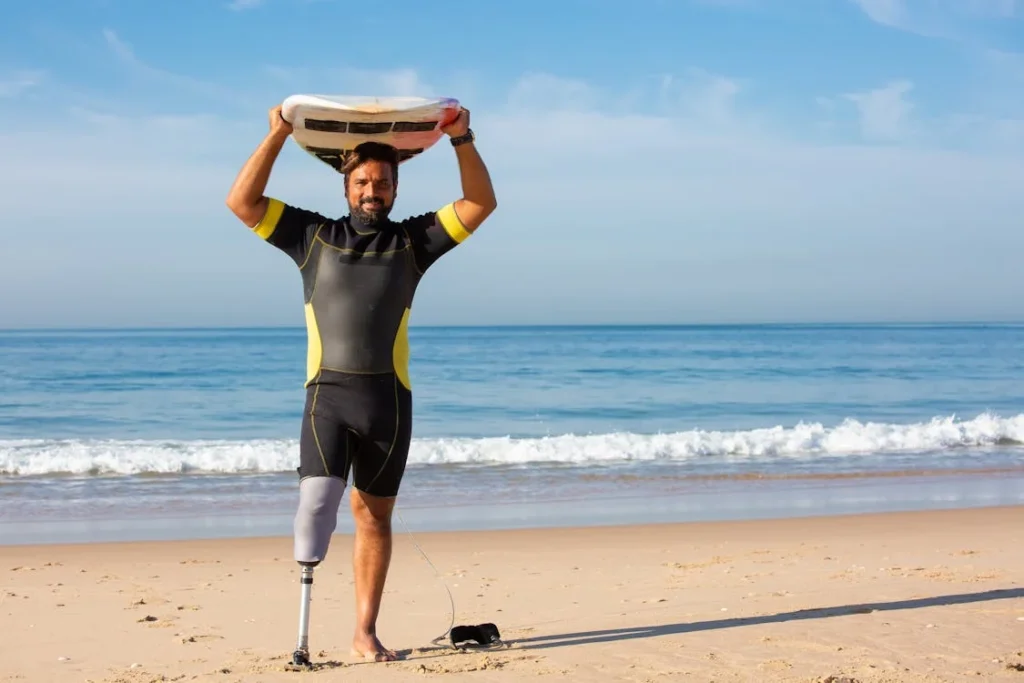
Why Doctors Recommend a Staged Timeline (and Not Rushing It)
It’s natural to want to get back to normal life as quickly as possible after an amputation. Many patients ask, “How soon can I walk again?” or “Can I get my permanent prosthesis next week?” These questions come from a place of courage and hope, and they’re a good sign.
But every experienced doctor and prosthetist will give the same advice: go step by step.
Healing Happens in Layers
The body needs time to adjust to any major surgery, and amputation is no exception. At first, the wound must close. Then the tissue under the skin needs to become stronger.
After that, muscles, joints, and skin must get used to pressure, movement, and the weight of a prosthetic device. None of this happens overnight.
If you rush any of these steps—like fitting a prosthesis while swelling is still present, or before the skin is ready—you risk discomfort, infections, and setbacks.
That’s why doctors recommend moving in stages. Each phase builds on the last. When done right, each step sets the stage for better comfort, better motion, and better confidence later on.
Protecting the Residual Limb
Doctors are especially careful with the residual limb. This part of the body needs time to toughen up. Right after surgery, the skin is very sensitive. The tissue underneath is soft, and even a small amount of pressure from a socket can cause pain or even skin damage.
Wearing a prosthesis too early, especially a poorly fitted one, can cause swelling, blistering, and long-term discomfort. If that happens, the patient has to stop using the device, which delays progress. It also lowers motivation and can lead to frustration or anxiety.
When doctors take their time and follow a timeline, they’re not being overly cautious—they’re being smart. They know that a limb prepared with patience is one that will accept a prosthesis more easily and with far fewer complications.
Understanding Your Body’s Signals
Another reason for the staged approach is that everyone’s body heals at its own pace. One person might be ready for a temporary prosthesis at six weeks.
Another might need eight or ten. A young, healthy person may heal fast. An older person with diabetes or circulation issues might need more time.
That’s why doctors don’t follow a strict calendar. They follow the body. They look at the wound. They measure the limb. They talk to the patient. Every visit gives them clues about what’s happening inside the body. These clues help them make safe, smart decisions.
Prosthetists and physical therapists play a key role here too. They monitor how the patient moves, how they balance, and how their skin reacts. All this information is shared with the doctor, who then decides whether to move to the next step or wait a bit longer.
Building Mental and Emotional Strength
A staged timeline also gives the patient time to process what’s happening. Losing a limb is emotional. It changes how a person sees themselves, how they interact with others, and how they experience daily life.
Trying to rush through the process often leads to emotional burnout. It might feel good in the short term, but it can be overwhelming. Patients need time to adjust, to rebuild confidence, and to learn how to use their bodies in new ways.
That’s why rehab programs often include counseling or peer support. These tools give people space to talk, to reflect, and to stay focused. They help patients stay strong—not just in their muscles, but in their mindset.
Doctors know that mental strength is just as important as physical recovery. A person who feels supported and informed is more likely to stick with the process, ask for help, and speak up if something doesn’t feel right. And that makes all the difference.
Better Long-Term Results
Following a staged timeline doesn’t just make the process smoother—it leads to better long-term outcomes. When each stage is given the time it needs, the prosthesis fits better, lasts longer, and works more naturally with the body.
Patients are more likely to stay active, avoid pain, and use their device regularly. They gain confidence faster and are more independent. They’re also less likely to need revisions, replacements, or extra medical treatment later on.
That’s why doctors, prosthetists, and therapists all recommend going step by step. It’s not about slowing you down. It’s about setting you up for success—for months, years, and a lifetime of movement ahead.
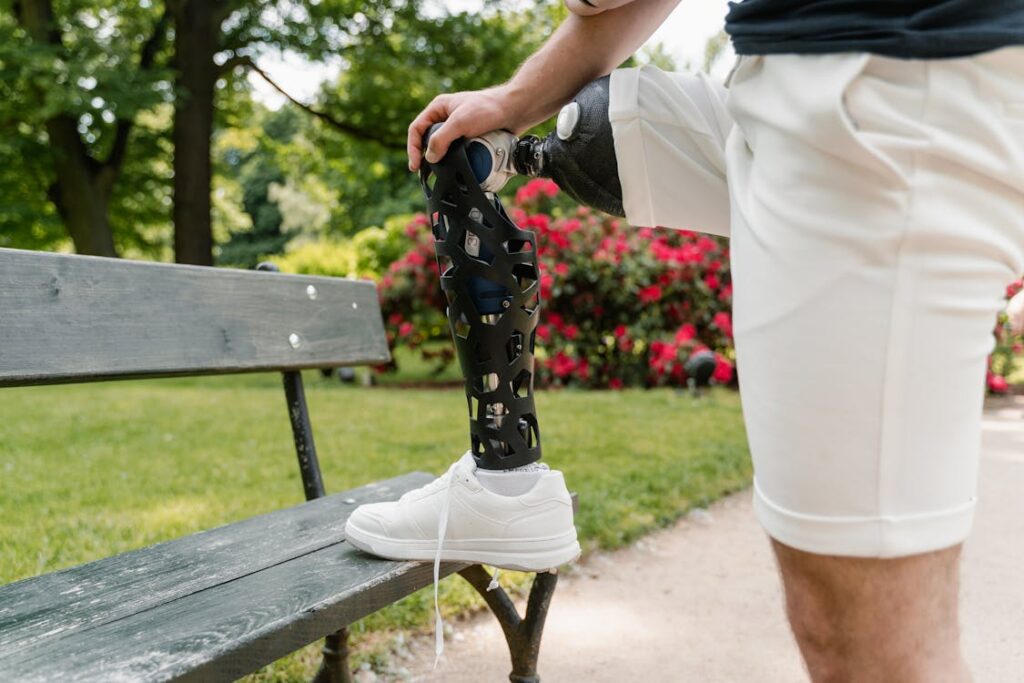
The Role of Phantom Limb Sensation in Prosthetic Timing
One of the lesser talked-about aspects of life after amputation is phantom limb sensation—when a person feels as though the missing limb is still there.
This can range from a mild tingling to more intense pain, and while it’s a very real experience, it can be hard to explain to others who haven’t felt it. What’s more, it can directly influence the timing and success of prosthetic fitting.
What Is Phantom Limb Sensation?
After an amputation, the nerves that used to carry signals from the missing limb don’t simply shut off. The brain still remembers the limb. It still tries to send and receive signals to and from that part of the body.
That’s why some people feel like they can move their missing toes or fingers. Others may feel cramping, itching, burning, or sharp jabs—even though the limb is no longer there.
This isn’t just a mental trick. It’s the nervous system adjusting to a major change. Sometimes, this sensation fades with time. Other times, it can continue for months or even years.
When phantom sensations become painful or constant, it can slow down the recovery process and affect how well a person adapts to a prosthesis.
How It Affects the Fitting Timeline
Doctors and prosthetists take phantom limb sensation seriously, especially when it’s severe. If the sensation is causing strong pain or discomfort, it may be difficult to wear a prosthesis for extended periods.
The brain becomes confused—it’s trying to deal with a missing limb, a new prosthesis, and pain signals all at once. This confusion can lead to poor balance, reduced focus during therapy, and in some cases, a refusal to use the prosthesis at all.
Because of this, prosthetists may delay the first fitting slightly to allow the body and brain to calm down. Alternatively, they may proceed with a very gentle fitting schedule—shorter wear times, softer socket materials, and frequent check-ins.
This slow exposure helps the nervous system adapt to the new sensation of wearing a prosthetic limb, while gradually reducing the intensity of phantom sensations.
There’s also a growing field of research that shows how early use of a prosthesis—even during mild phantom pain—can actually reduce these sensations over time.
The prosthesis gives the brain a new structure to focus on, which can help override the confusing signals left behind by the amputation. But this only works when the fitting is done carefully, with lots of attention to comfort and feedback.
Therapies That Support the Timeline
Managing phantom limb pain doesn’t just happen with time. There are specific therapies designed to help, and using them in the early weeks after surgery can speed up the readiness for prosthetic fitting.
Mirror therapy, for example, involves placing a mirror in such a way that it reflects the existing limb, creating the illusion that both limbs are intact.
This simple technique can retrain the brain and often reduces phantom pain significantly. Tactile desensitization, massage, and even certain mental visualization exercises are also useful.
When these therapies are started early and paired with well-timed prosthetic fittings, they can help patients get through one of the most mentally exhausting parts of the recovery journey.
Patients not only begin to feel better physically, but they also gain back a sense of control. And that control builds confidence—the kind that lasts well beyond the hospital or clinic.
The Importance of Talking About It
Perhaps the most important takeaway is that patients must be encouraged to talk about phantom sensations. Many feel embarrassed or unsure whether it’s “real.” They might hide their symptoms or dismiss them as personal weakness.
But the truth is, phantom limb sensation is incredibly common. Ignoring it doesn’t make it go away. Addressing it early—with your doctor, your prosthetist, your therapist—opens up new options for care, and can even adjust your fitting timeline in ways that are safer and more effective.
At Robobionics, we never rush someone into a prosthesis if they’re clearly struggling with phantom pain. Instead, we listen, we evaluate, and we work closely with the rehab team to find the right moment to begin.
Because when the mind and body are both ready, the prosthetic limb doesn’t feel like a burden—it feels like freedom.
Conclusion
The journey to prosthetic fitting is not about racing to the finish—it’s about choosing the right path at the right pace. Every stage, from early healing to wearing a permanent limb, plays a vital role in how well a person adapts, heals, and thrives. Doctors recommend a staged timeline not to delay progress, but to protect it—to ensure that each step forward is secure, stable, and lasting.
At Robobionics, we believe in listening to the body, understanding the mind, and trusting the process. Whether it’s managing phantom pain, strengthening muscles, or adjusting the perfect socket, every decision is guided by your comfort and long-term well-being. When the timing is right, a prosthesis becomes more than a tool—it becomes a doorway to independence, movement, and renewed confidence.
If you or a loved one is on this path, know that you don’t have to walk it alone. Trust your medical team, speak openly about your concerns, and give your body the care and time it needs. The right moment will come—and when it does, you’ll be ready to step into it, fully and fearlessly.



